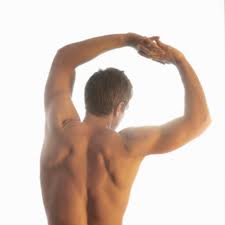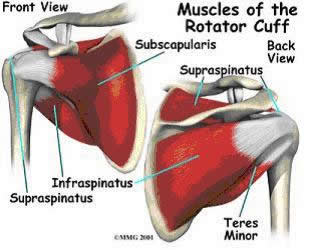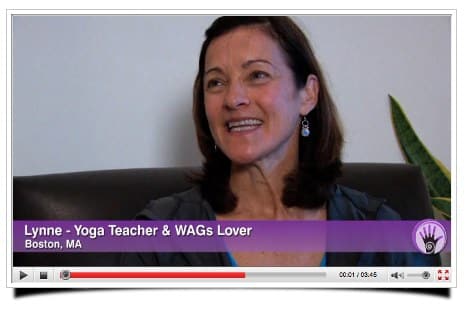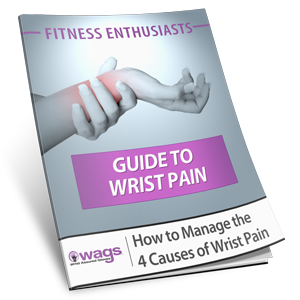The Shoulder and Rotator Cuff Injuries

Part 1 covered the anatomy of the shoulder and common causes of shoulder pain including rotator cuff injuries, impingement syndrome and Adhesive Capsulitis (i.e. frozen shoulder).
Shoulder injury treatment options will vary depending upon the type of injury and severity of symptoms. A professional diagnosis may be warranted to determine the extent of your injury. If a fracture, bone spur or rotator cuff tear is suspected an X-ray or MRI will be ordered. Seeking a comprehensive treatment plan from a qualified practitioner for anything more than mild shoulder pain is recommended.
Below you’ll find some traditional and alternative non-surgical treatment options that may be beneficial.
Rest and Ice
As an initial response to injury, rest and ice is recommended. Discontinue all movements that results in pain and try to completely rest the shoulder or to only move within your range of comfort. Ice the affected area to reduce inflammation several times daily for 10 minutes at a time. A bag of frozen peas drapes well over the shoulder or you can purchase a shoulder ice wrap to cover a larger area. Ignoring shoulder pain will only exacerbate the symptoms and can gradually cause more damage to the rotator cuff and shoulder joint capsule. Believe me -I know!
Check for Proper Alignment
A chiropractic assessment will ensure that all structures are properly aligned. After my fall and shoulder injury my wrist (1st row of carpal bones), elbow (head of the radius bone) and shoulder (humeral head or arm bone) were all out of alignment in the direction of impact from my slip on the ice. These misalignments were not only causing inflammation and problems with the joint mechanics, but median nerve compression as well. Wrist misalignments can set off a chain reaction leading to major shoulder issues.
We typically think of median nerve compression affecting the hand such as in carpal tunnel syndrome; however, compression of the median nerve can also ‘shut down’ or compromise the nerve impulses to the shoulder muscles, since the nervous system is a closed loop system. In my case, a manual muscle test revealed significantly reduced strength in the large muscles (pecs, traps, lats & deltoid) that assist with shoulder movement. When the large shoulder muscles only function at ~20% strength this puts a great deal of strain on the smaller rotator cuff muscles causing biomechanical problems and possibly rotator cuff tears. The median nerve compression was relieved with the realignment of my carpal bones and to my surprise subsequent muscle testing showed improved strength in my shoulder muscles almost immediately, indicating the nerve impulses were firing and the muscles were ‘turned on’ again.
A word of caution to yogis and fitness enthusiasts… It doesn’t take a fall on the hand to misalign the carpal bones and compress the median nerve. Repetitive weight bearing on the hands can overstretch the wrist ligaments, shift the carpal bones and have the same effect. My chiropractor said that he frequently adjusts the wrists of his yoga practicing patients and shoulder issues due to compromised shoulder strength often accompanies their wrist problem.

Immobilize
Immobilization through bracing can accelerate healing of injured ligaments or tendons. A brace to immobilize my wrist was needed to hold the carpal bones in correct alignment after the chiropractic adjustments. Again, although the greater problem was in my shoulder, the wrist and median nerve compression was a contributing factor, so the wrist was treated too. I wore the wrist brace full time for 2 weeks then primarily at night to prevent wrist flexion while I slept. Immobilization should only be a short term solution, since prolonged bracing can result in joint stiffness, weaken muscles and loss of motion.
Myofascial Release
Myofascial release was a key component in my healing. In combination with bracing and intermittent chiropractic adjustments I began seeing an advanced myofascial release practitioner. Fascia is dense fibrous tissue that covers and connects ours muscles, bones, nerves, blood vessels and organs. Like a web, the fascial system is one continuous structure that exists from head to toe without interruption. Myofascial release is an effective hands-on technique applying sustained gentle pressure to release the connective tissue restrictions to restore movement and eliminate pain. With each session the misalignments in my wrist, elbow and shoulder resolved and shoulder movements were gradually improving. The pain was lessening but was still very intense with abduction, rotation or sudden jarring.
Reiki & Gua-Sha
Reiki is a Japanese technique for stress reduction and relaxation that also promotes healing. It is based on the idea that if one’s “life force energy” is low, then we are more likely to get sick or feel stress, and if it is high, we are more capable of being happy and healthy. It’s safe, relaxing and works in conjunction with all other medical or therapeutic techniques to promote recovery.
Gua sha, an ancient medical treatment, means literally “to scrape away disease” and promotes “Qi”or vital life energy. Gua sha or friction stroking with a smooth edge such as soup spoon is placed against the skin surface, pressed down firmly, and then moved down the muscles. This moves stagnated blood and energy promoting normal circulation and metabolic processes. Although the resulting red marks on the skin may look painful, they are not. Patients often feel immediate sense of relief and I can certainly attest to this as the intense pain that had traveled down my arm disappeared after treatment.
A similar western version of gua sha is The Graston Technique® that incorporates a patented form of stainless steel instrument-assisted soft tissue mobilization.
Orthopedic Evaluation / MRI / Cortisone Injection
With my shoulder injury the MRI ruled out a bone spur or rotator cuff tear and revealed significant swelling with thickening in the joint capsule and 2 frayed rotator cuff tendons. Adhesive Capsulitis or “Frozen Shoulder” was diagnosed and a cortisone injection was given. The pain accompanying an inujured shoulder often results in lack of use and ‘guarding’ the arm to prevent bumping which causes further joint stiffness and loss of movement. Daily activities can be significantly limited from the lack of shoulder motion in all directions with a frozen shoulder. A cortisone injection reduces the pain and inflammation so the affected arm can be used and motion gradually restored. The effects last for approximately 8 weeks. Typically a frozen shoulder takes 12 to 18 months to ‘thaw’ and fully regain movement. But these frozen shoulder pain relief options can certainly help in the meantime.
Stretching and Strengthening
With the pain and inflammation diminished passive stretching along with gentle strengthening can begin as functional use of the arm resumes. A great book Treat your own Shoulder by Robin McKenzie provides a graduated sequence for regaining shoulder motions in a safe pain free manner. An innovative tool for stretching the internal and external rotators is a plastic L shaped device called The Rotater.
A water exercise routine for gentle strengthening can be effective. I found swimming in Cape Cod Bay in the early summer very soothing (numbing!) and the cold, alkaline salt water helped reduce inflammation. As strength and range of motion improve other activities within pain tolerance can be added. I added biking and kayaking for short distances, as well as a modified yoga and Pilates, but avoided full weight bearing exercises and weight lifting. Always be mindful of just pushing to the point of discomfort, particularly with rotator cuff strains, and stopping any exercise or activity that result in pain.
Once 75% of my shoulder motion was achieved, I added twice weekly physical therapy sessions for shoulder and scapular mobilization along with a full strengthening program that included upper arm bike, theraband exercises, light weights, weight bearing and the Body Blade. The body blade is great for isometric strengthening and joint stabilization.
Review
Shoulder injuries can be complex, take an extended time and multiple approaches to heal. I personally found mine to be an exercise in cultivating patience! Using both traditional and non-traditional treatments can provide a more comprehensive approach to healing. Each injury is unique and should be evaluated by a healthcare practitioner to develop a therapy regime that is specific to the individuals needs and considers their lifestyle, work and leisure activities. If you’re also experiencing wrist pain during your exercises, check out our selection of workout gloves with wrist support.




